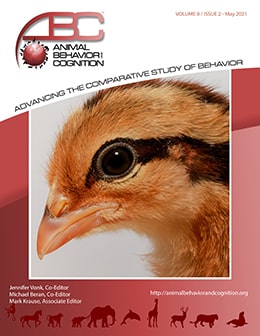Vol 8, Issue 2, May 2021
Responses of Female Yellow Warblers to Playbacks Signaling Brood Parasitism or Predation Risk: A Quasi-Replication Study
Citation
Lawson, S. L., Enos, J. K., Mendes, N. C., Gill, S. A., & Hauber, M. E. (2021). Responses of female yellow warblers to playbacks signaling brood parasitism or predation risk: A quasi-replication study. Animal Behavior and Cognition, 8(2), 216-230. https://doi.org/10.26451/abc.08.02.08.2021
Abstract
Many avian species are negatively impacted by obligate avian brood parasites, which lay their eggs in the nests of host species. The yellow warbler (Setophaga petechia), which is host to the brood-parasitic brown-headed cowbird (Molothrus ater), represents one of the best-replicated study systems assessing antiparasitic host defenses. Over 15 prior studies on yellow warblers have used model-presentation experiments, whereby breeding hosts are exposed to models of brown-headed cowbirds or other nest threats, to test for anti-parasitic defenses unique to this species. Here we present results from our own quasi-replication study of the yellow warbler/brown-headed cowbird system, which used a novel design compared to previous experiments by pivoting to conduct acoustic playback treatments only, rather than presenting visual models with or without calls. We exposed active yellow warbler nests to playbacks of brown-headed cowbird chatters (brood parasite), blue jay (Cyanocitta cristata; nest predator) calls, conspecific “seet” calls (a referential alarm call for brood parasitism risk), conspecific “chip” calls (a generic alarm call), or control wood thrush (Hylocichla mustelina; harmless heterospecific) songs during the incubation stage. Similar to previous studies, we found that female yellow warblers seet called more frequently in response to playbacks of both brood parasitic chatter calls and conspecific seet calls whereas they produced more chip calls in response to the playback of nest predator calls. In contrast, female yellow warblers approached all playbacks to similar distances, which was different from the proximity patterns seen in previous studies. Our study demonstrates the importance of both replicating, and also pivoting, experimental studies on nest defense behaviors, as differences in experimental design can elicit novel behavioral response patterns in the same species.
Keywords
Alarm calling, Antiparasitic defenses, Brood parasitism, Host-parasite interactions, Nest-protection, Playback presentations, Referential alarm call
